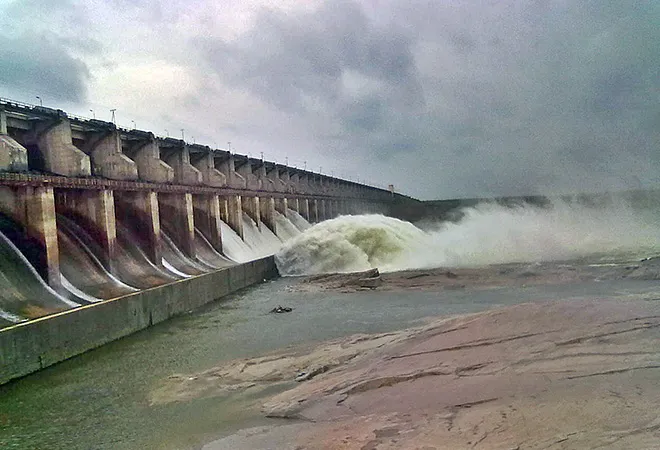
In this essay, I assert the existence of three prime stressors causing interstate water conflicts in India. These three stressors are: a) the federal structure of the nation, where water has been made part of the State list; b) wrong delineation of the food security policy leading to dominance of high water-consuming crops like rice and wheat in production and procurement; and c) lack of an integrated ecosystems approach in understanding the land-water-food nexus in the water policy of the nation. All three factors point to lack of holism in water governance paradigm. Let me explain each point one by one.
Conflictual Federalism
The Schedule VII of the Indian Constitution confers power on the states to decide on the use of water for various purposes like water supply, irrigation and canals, drainage and embankments, water storage and water power (Entry 17 of List II – State List), subject to the provisions of Entry 56 of List I. Interestingly, desite the fact that ‘interstate water’ has been explicitly mentioned in the Union List, there is no such acknowledgement in the State List. This allows the states to delineate the “user rights” over waters in ways deemed best by them. To avoid controversies arising from such ambiguities, the Union Government has generally avoided any proactive approach towards basin-level governance in practice, and has confined its role in setting up Tribunals under exigencies of interstate water disputes. This creates a situation of interstate water conflicts: a phenomenon described as “conflictutal federalism”.
An example of “conflictual federalism” is that of the Cauvery water disputes, where the conflict is contingent upon divergent delineations of property or user rights over water by the co-riparian states of upstream Karnataka and downstream Tamil Nadu. Axiomatically, the three extreme principles for delineations of property and user rights over water are classified as
Harmon, History and Hobbes. The Harmon doctrine, based on the anachronistic thinking: “
if water falls on my roof, it is mine” bestows the primary rights on those who are at the source of the water. In that sense, it is largely skewed towards the upstream users. History is akin to “prior appropriation” principle and awards primary rights of water to the users who are the first appropriators of the resource over time, irrespective of location. The Hobbesian doctrine acknowledges the rights arrived through a process of negotiation between co-riparians.
In the Cauvery case, downstream
Tamil Nadu’s intervention over water dates back to the Chola dynasty (200 AD), with major water development initiatives taken by the Madras Presidency in the early 19th Century. Given this long history of water use for paddy in the Cauvery delta as also the basin area contribution to river flow, Tamil Nadu maintains that the principle of prescriptive rights given in the 1924 agreement between the Princely State of Mysore and Madras Presidency, should form the basis of user rights delineation. This is tantamount to the principle of prior appropriation or the historical doctrine.
Karnataka, being a late starter in irrigation development, has contested the doctrine of prior appropriation. Rather, it has maintained that under periods of scarcity, the downstream state cannot have a claim over the waters, unless the needs of the upstream are met. This position is tantamount to “absolute territorial sovereignty” (or Harmon doctrine) at the sub-national scale. Therefore, it is the federal structure that has resulted in non-acknowledgement of water as an integrated flow regime at the basin-scale. In that sense, water conflicts need to be interpreted as conflicts over property rights definition. Such interstate conflicts ubiquitous as observed in the cases of Punjab-Haryana water sharing, as also over the Krishna and other interstate rivers in India.
Minimum Support Price regimes
The second stressor that I would like highlight is the wrong delineation of our food security by reducing its definition to producing and procuring high water-consuming paddy and wheat. It all began with the Green Revolution in the late 1960s, continued with the introduction of minimum support price (MSP) mechanism in the late 1970s, and eventually the governmental procurement policies through the Food Corporation of India (FCI) and state procurement agencies. The Green Revolution was not only successful in increasing the yield and production of foodgrains, but also helped in bringing more areas under cultivation of irrigated paddy and wheat. These largely happened at the cost of lower water-consuming millets like Ragi and Sorghum which were displaced in many areas. In this process, the phenomenon of minimum support prices (MSP) played an important role.
MSP was introduced in the late 1970s, with procurement agencies like the FCI beginning to procure at the support price regulated by the Commission on Agricultural Costs and Prices. Over time, MSP became the “floor” price-setter for rice and wheat. Between 1980 and 2000, the
MSPs of rice and wheat increased at a much faster rate than those of the “coarse” cereals, which eventually led to movement of the terms-of-trade (defined as ratio of prices of two competing crops, e.g. rice and millets) in favour of the water-consuming cereals. This led to acreages moving largely in favour of water consuming staples, whose crop-water requirements are 10 times of that of the drier millets. This led to manifold increase in water demand, thereby resulting in many interstate water conflicts (e.g. the Krishna, Cauvery, Teesta basins or between Punjab and Haryana). While some agricultural economists often argue that irrigation in India is largely groundwater-dependent, they often forget the integrity of water systems and hydrological cycles: groundwater and surface flows are intrexicably linked and feed on each other. It is groundwater depletion that has created pressure on surface flows, and vice-versa.
Lack of an integrated approach
That the water governance architecture in India is based on a fragmented piecemeal approach, rather than integrated basin approach that takes a holistic view of the land-water-food nexus. The “conflictual federalism” and the pricing mechanism that promotes production of water-consuming crops without much concern about the ecosystem services associated with organic hydrological regimes is symptomatic of this fragmented approach of water governance. The water technocracy dictating water governance in India seems largely oblivious of the globally changing paradigms of Integrated River Basin Governance. Their disciplinary allegiance to traditional structuralist engineering brought in India by the British administration is extremely prominent.
From the pre-independence legacy of the Sarada Barrage, and the Upper Ganges Canal, and continuing with projects like Damodar Valley Corporation, Bhakra-Nangal, Tehri, Farakka, etc structural interventions over flow regimes rule the roost with scant recognition of the associated externality costs through downstream ecosystem damages having bearings on livelihoods. A series of hydropower projects over the Teesta river in Sikkim and North Bengal has completely disrupted the river connectivity, thereby leading to water disputes between Bangladesh and India over dry season paddy cultivation in both nations.
Contrary to an integrated and holistic thinking, water governance in India relies on a few stand-alone numerical measures of physical state of the resource: a paradigm more aptly described as “arithmetic hydrology”. One critical example of such thinking is interlinking of Indian rivers. The entire project is contingent upon the premise of transferring water from “surplus” to “deficit” river basins. While the
definitions of “surplus” and “deficit” basins go against the fundamental tenets of the ecosystem processes associated with river basins, it is a clear exhibition of the fact that sheer physical availability defined solely in terms of per capita availability becomes the decision variable for water management. The social, ecological, and cultural processes associated with water are therefore completely ignored. This is prone to induce more water conflicts in India.
Further, such “arithmetic hydrology” can also be witnessed in the
2007 Award of the Cauvery Water Tribunal. The Tribunal arrived at a figure of 740 TMC of water for allocation, with an assumption of 50 percent dependability based on past estimates. While this figure is questionable, the sheer arbitrariness in the Award arises with the reservation of “quantity … for environmental protection” and “quantity … for … escapages to the sea” as 10 TMC Ft and 4 TMC Ft respectively. River flows are therefore reduced to a few numbers without any scientific rationale, or acknowledgement of broader linkages of the society, and ecosystem processes and services associated with flow regimes. Such modes of allocations have essentially accentuated the conflict even further. Even the institutional structure of the Cauvery Water Management Board is inflicted by such reductionism, being dominated by engineers. A holistic knowledge base through a trans-disciplinary approach needed to govern a disputed river basin like Cauvery therefore goes missing.
Holism as opposed to Reductionism
A 2016 report from the erstwhile MoWRGR, GoI, titled
A 21st Century Institutional Architecture for India’s Water Reforms, prepared under the chairmanship of Dr Mihir Shah, acknowledges that water governance is a complex issue requiring a multi-disciplinary approach. This is possible by combining elements from natural sciences, engineering, ecological economics and other social sciences. This report has led to a war of paradigms between those who propagate the structuralist engineering and those who embed their contentions on a holistic governance mechanism. Governing a flow regime requires a holistic approach keeping in view the integrity of the ecohydrological cycle, rather than a fragmented approach responsible for the three stressors of interstate water conflicts in India.
The views expressed above belong to the author(s). ORF research and analyses now available on Telegram! Click here to access our curated content — blogs, longforms and interviews.



 In this essay, I assert the existence of three prime stressors causing interstate water conflicts in India. These three stressors are: a) the federal structure of the nation, where water has been made part of the State list; b) wrong delineation of the food security policy leading to dominance of high water-consuming crops like rice and wheat in production and procurement; and c) lack of an integrated ecosystems approach in understanding the land-water-food nexus in the water policy of the nation. All three factors point to lack of holism in water governance paradigm. Let me explain each point one by one.
In this essay, I assert the existence of three prime stressors causing interstate water conflicts in India. These three stressors are: a) the federal structure of the nation, where water has been made part of the State list; b) wrong delineation of the food security policy leading to dominance of high water-consuming crops like rice and wheat in production and procurement; and c) lack of an integrated ecosystems approach in understanding the land-water-food nexus in the water policy of the nation. All three factors point to lack of holism in water governance paradigm. Let me explain each point one by one.
 PREV
PREV


